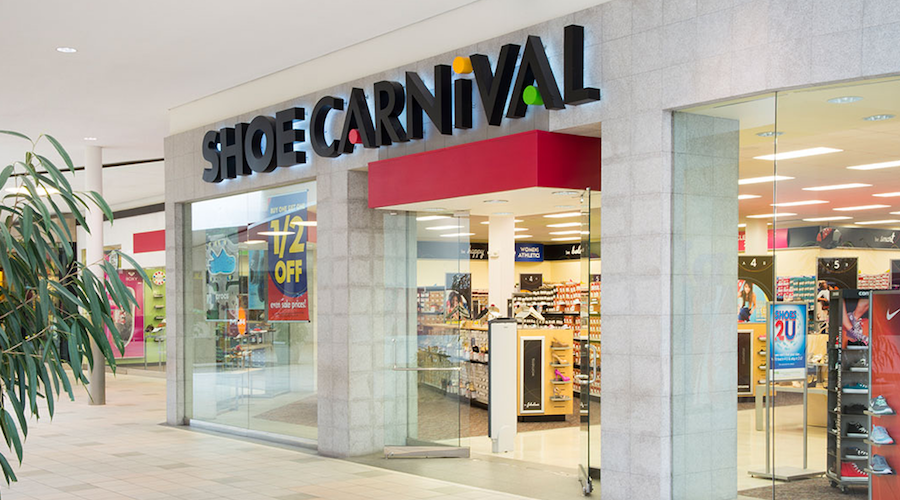Shares of Shoe Carnival rose $3.68, or 22.4 percent, to $20.10 on Thursday after the off-price chain reported second-quarter results came in above estimates and August same-store sales ran up 7 percent.
In the quarter, earnings slid 5.1 percent to $3.9 million from $4.1 million in the same period a year ago. Due to reduced shares on average, EPS increased to 24 cents from 22 cents, exceeding Wall Street’s consensus target of 20 cents.
Sales improved 1.4 percent to $235.1 million, also topping Wall Street’s average target of $232.3 million. Comparable store sales inched up 0.4 percent. Comps grew low-single digits in May, were flat in June and were down slightly in July due to delayed back-to-school spending.
On a conference call with analysts, CEO Clifton Sifford noted that the company had already indicated that sales were again driven in each market by their actual back-to-school dates and tax-free holidays in certain states. Two notable changes around tax-free holidays included Alabama moving to July from August and Georgia deciding not to have tax-free holidays this year after traditionally holding the event in July. Sales were also hurt by shifts in a few back-to-school dates as school systems continue to move opening dates later in the calendar.
Given these headwinds, Sifford was “pleased” to generate a comp gain and noted that positive momentum carried forward with August showing a 7 percent comp gain.
For the quarter, conversion was up slightly while average dollars per transaction and units per transaction were both up low single digits. These factors helped offset low mid-single-digit decline in brick-and-mortar traffic.
By category, adult athletic was down slightly on a comparable basis due to a decline in men’s basketball. But overall the category was encouraging with women’s athletic posting a mid-single-digit increase for the quarter. Running categories in both men’s and women’s continue to show strength.
Asked about athletics in the Q&A session, Sifford said sport sandals “were extremely strong” during the quarter.
“So we’re pleased with the performance of the seasonal product,” said Sifford. “But the true driver as we went through the quarter was out of our women’s athletic, out of our kid’s athletic and out of the running categories in both men’s and women’s. The other reason the men’s athletic business was just very slightly down was because we’re the strongest seller of basketball in the family channel. And as you know, the basketball category has not been particularly in favor at this time.”
Among other categories, women’s non-athletic ended the quarter up low-single digits on a comp basis. Women’s dress shoes continue to perform better than expectations, posting a comparable store increase in the teens. Junior shoe categories also continue to perform well.
Men’s non-athletic ended the quarter up slightly on a comp basis. Said Sifford, “Men’s dress shoes and boat shoes continue to be a challenge. However, we saw positive results from our traditional casual categories and from sport boots and hybrids.”
Children’s shoes were up low-single digits, led by sandals and boys and girl’s athletic.
Gross margins were flat at 29.0 percent compared to the second quarter of last year. Merchandise margin, along with buying, distribution and occupancy expenses as a percentage of sales remained flat.
SG&A expenses increased to 26.3 percent of sales compared to 26.1 percent as overall expenses grew due to a $1 million increase in expenses for new stores net of expense reductions for stores that have closed and a $916,000 increase in impairment of long-lived assets.
Inventories ended the quarter up 0.6 percent on a per store basis due to later back-to-school dates and Shoe Carnival remains on plan to end the year with per store inventory down mid-single digits.
Regarding expansion, Shoe Carnival has identified an additional 30 to 35 stores it will close if it cannot improve their financial performance to a minimum contribution expectation. Said Sifford, “Even though this would reduce our overall sales volume, we would realize long term improvement in operating income and EPS.”
New store openings for 2018 will be in the low single-digit range. Sifford added, “We remain committed to long term strategic store growth. However, with the changing landscape in brick-and-mortar stores, we believe more attractive real estate opportunities will be available to us if we exercise patience.”
Shoe Carnival ended the quarter with 418 stores. For the remainder of the year, it expects to open 7 stores and close 16 to 18.
Looking ahead, Shoe Carnival raised the low end of its previous earnings guidance and now expects EPS of $1.35 to $1.45 compared to prior expectation of $1.30 to $1.45. Gross margins in the second half are expected to be flat, with SG&A cost decreasing slightly as a percentage of sales.
Sales are still expected to land in the range of $1.006 billion to $1.02 billion, with comparable store sales flat to down low single digits.
“We believe the positive athletic and athleisure trend happening in the family footwear category will continue and we have reallocated inventory dollars to those specific categories for the fall season to take advantage of this trend,” said Sifford. “For the majority of our other footwear categories, the month of September and October will depend on the weather as it always has. We expect, once cooler weather arise, it will fuel the bootie and sport casual categories.”
As management has stated previously, boot sales are being planned “very conservatively” with preparations being made to chase product if demand is greater than expected. The tight inventories on boots is expected to limit markdowns although margins will be impacted by the planned closing of 16 to 18 stores.
Photo courtesy Shoe Carnival
















